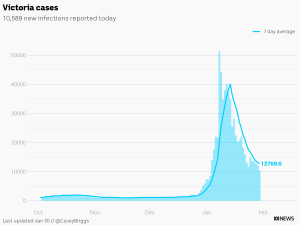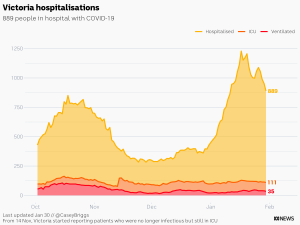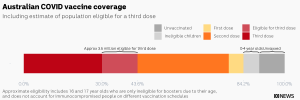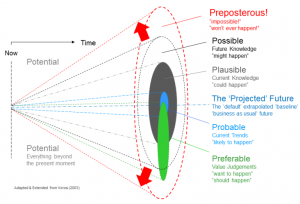Victoria, Australia, COVID, and the Next Six Months – a Central Scenario
A continuation of an irregular series of scenarios to help people think about strategy
I have been talking to a business this week that has a critical need to try and understand what its workforce looks like in mid March and beyond. They have had significant work force challenges due to people being absent from work due to having to isolate over the last few weeks as the latest wave has grown in Victoria.
While I do not do forecasts I certainly do scenarios and I do that to talk people though my logic so they can do their own scenarios and make decisions. I have talked them through the following centra scenario plus some of the major things that might change that picture.
Assumptions
In any scenario work it is critical to detail your assumptions because you are telling a story based on those assumptions. If you want to then you can skip the assumptions and scroll down to the scenario story and come back to check on my assumptions as you read.
Two Populations
I am fond of the old saying that if you have one foot in a bucket of ice and one foot in a bucket of boiling water then on average you are comfortable. The current wave in Victoria looks like this:


Source: Casey Briggs:
With the caveat that the case numbers have been mucked around due to the testing problems and confusion we have had with some tests being reported many days after they were taken and many people not being able to access tests. Therefore the hospitalisation figures are much more reliable.
However I believe that this overall picture hides two sub populations in Victoria. The first of those is made up of two groups:
- Those that have no choice but to mix with others because their job requires it.
- Those that have decided bugger it, we are just going to get on with our lives.
The second population is made up of people that are reducing their risk of getting infected. This includes people having to isolate having been close contacts and those reducing the number of people they interact with to reduce risk. Some because they want to get a booster vaccination before they resume a more normal life.
I do not know how big those two respective populations are but the mobility and spending data that we are seeing indicates quite a large group in the second population: There’s no Victorian COVID-19 lockdown, but Melburnians are choosing to stay home anyway
Wave Dynamics
The UK gives us some indicators about waves with Omicron:

Source: UK GOV
With the caveat that they are in winter, have different restriction settings and have had many more infections before this wave. What the UK data shows is that:
- Wave of case numbers from bottom to top took 3 weeks once it really got going.
- Fall – case levels halved in about 10 days although that rate is slowing in the last week – i.e. still falling but at a slower rate.
The current Victorian data seems to be on a similar path although the messiness created by testing issues makes that difficult to fully assess.
School mixing
We will see the schools re-open in the first week of February and this will see children mixing with different groups than they have done over the summer holidays. My view is that this will result in more mixing and spreading as more children get infected and spread that infection back through households. This is also likely to coincide with a significant number of people relaxing their isolation as the current wave falls ( an assumption in itself).
Winter is coming (sic)
A large number of the Pandemic waves have coincided with winter as people have less options for mixing and socialising outside and ventilation rates fall. This is obviously true of colds and the flu. The Japanese experience shows what a relatively well controlled outbreak can turn into in the middle of winter:

Source: Worldometers
The theory is that they had a mid to late summer surge as it was too hot and people stayed indoors
That a combination of restrictions and cooler weather that allowed people to go to prioritise outside events with high masking rates and increased vaccination brough numbers down (7 day ave was 97 on Dec 1) and of course not Omicron.
Then winter caused a new surge as in many countries, especially with Omicron. Now the 7 day average is over 62,000 cases and climbing rapidly with over 82,000 cases reported on Jan 29th.
Vaccination Progress
We are seeing good progress on vaccination in Australia:

Source: Casey Briggs
My assumption is that we will continue to get good coverage for the third dose although it will be less than the coverage for two doses. Firstly because it can never be higher and secondly because the early group of people that had AZ vaccination are very keen for an mRNA booster but the later groups may be less keen. Especially if this current wave fall steadily from here and a significant number of people believe it is finally over (again).
So – The Central Scenario
So my central scenario (or probable scenario in Foresight Cone terms):

Is:
- The current wave will continue to fall in cases numbers (with falls in hospital numbers and deaths lagging that fall) rapidly for a few more days then more slowly after that.
- We will get a second wave as the schools re-open and a couple of transmission cycles lead to a rise in cases again around the end of the second week in February. That wave will again climb rapidly but be not as high as the current wave as there are less people to infect and booster levels are higher.
- That we will get a new wave in mid to late winter in a similar pattern to Japan but it will not be as high, although it might last longer due to climatic and ventilation issues.
From a workforce planning point of view a lower wave means less absences and I also suspect that governments may be less restrictive in the isolation rules.
Of course there are a number of factors that can push these scenarios into less probable scenarios including:
- The current isolating population being smaller than I suspect.
- The current isolating population being bigger than I suspect.
- Different behavioural responses from the population at large.
- Booster vaccination uptake being higher or lower than I suspect. Either dampening of increasing spread.
- The emergence of a new variant.
I want to make it clear that this is just very basic scenario work. There is no modelling that underpins what I have written. I have written it to provide people with a view and all the assumptions so they can think through their own issues.
The scenario described here is intended as provocations for further discussion and thinking. They should not be taken as specific advice. They are stories about a future that has not happened yet.
If you would like to see more of my writing you can subscribe to our bi-monthly newsletter:
P.S. I do not have any medical qualifications but I have experience as a large animal veterinarian in large scale disease outbreaks in animals. I also have experience in preparing for exotic disease outbreaks in animals in my previous role as a director of Animal Health Australia.
